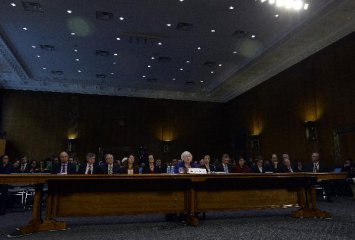
The US Federal Reserve basically remained unchanged of its policy in the new statement released on July 27 early morning (Beijing time) after two days of meeting, but only made some adjustments. Compared with the previous meeting, the Fed expressed more concern on weak inflation in latest statement. It indicated that it will implement its balance sheet normalization program “relatively soon”, while the previous said the time was “this year”.
The industry has different views on the statement. Whether the Fed will first raise interest rates or unwind its balance sheet? The movements also indicate investors’ concern on the issue. Immediately after the statement came out, the US exchange rate fell to over one-year low, but recovered slightly afterwards.
Analyst see dovish signals in slightly-adjusted statement
According to the statement, the Fed benchmark interest rate will remain unchanged at 1-1.25 percent. The Fed also noted that it will soon shrink its balance sheet provided that the economy evolves broadly as expected. It said that overall inflation on a 12-month basis is expected to remain somewhat below 2 percent in the near term. Near-term risks to the economic outlook appear roughly balanced, but the Committee is monitoring inflation developments closely.
In an email to the Shanghai Securities News, Naroff Economic Advisors chief economist Joel Naroff analyzed that more signs are showing that balance sheet unwinding is coming. He expected that the Fed will announce the decision at the November policy meeting; while the Fed is likely to announce an interest rates lift in December instead of September unless inflation in wages expands at a faster pace.
Gain Capital research director James Chen commented that the statement again stressed that “overall inflation is running below 2 percent”, while deleting the “somewhat”. Different from the expression “this year” in last month’s statement, the new statement said that the Fed will begin implementing its balance sheet normalization program “relatively soon”. On the whole, the subtle adjustment and consistency in monetary policy have no impact on the market’s dovish policy outlook. Obviously, there is any hawkish signal in the statement, and the time for the balance sheet normalization program is not clarified. The dovish signals after the statement release immediately impact the US dollar and gold.
Trading data shows that all the Dow Jones, S&P 500 and Nasdaq indexes went higher following the statement, and all settled at new highs. The New York gold futures hit 6-week high. The US dollar index fell below 93.4 from the intra-day high of 94.2376. It even declined to 93.15 at July 27 noon Beijing time, the lowest level since last June, but rebounded slightly later.
At 18:00 July 27 Beijing time, the US dollar index recorded 93.5746, an increase of 0.2 percent. New York near-month gold future moved up 0.94 percent to 1,261.1 US dollars per ounce. In the same period, the British and German stock markets dipped down; while the French CAC 40 index edged up 0.4 percent. Major markets in the Asia-Pacific region which closed earlier generally went up.
Policy mix raises concern, US dollar likely to remain weak for short run
Despite the slight recovery in the US dollar index, uncertainties of the Fed’s policy mix for the next half of this year are still regarded as barriers of the US dollar.
ICBC International chief economist Cheng Shi believed that what the interest rate hike can do cannot be replaced by the reduction of balance sheet. “Lifting interest rates before cutting balance sheet” is still the most reasonable policy mix.
There are several reasons. Firstly, similar to an interest rates hike, cutting balance sheet can also directly intervene in market interest rates. But by simply using balance sheet reduction to replace interest rates hike, it cannot diminish the negative impacts of monetary tightening. The impacts brought by cutting balance sheet are more difficult to predict and control. Secondly, different from balance sheet reduction, an interest rates hike will further weigh down the natural interest rate which is already low enough. This will impair financing institutions’ profitability, making them hard accumulate sufficient capital cushion and thus shaking the stability of the US financial system. Therefore, if using balance sheet reduction to replace an interest rates hike, it may take heavy policy cost.
Cheng also pointed out that the US dollar index is expected to remain weak for the short and medium run, and see shaper volatility amid ups and downs of economic indicators. Risks in the US stock market will continue to accumulate. Adjustment in valuation brought by a reversion in market sentiment will further intensify.
However, currencies in emerging markets are likely to benefit from it. FXTM vice-president Jameel Ahmad believed that what really supports the Chinese yuan and other emerging market currencies is that the Fed did not make solid stance for when it will raise interest rates next time. This indicates a change of the Fed’s attitude. Previously, all signals from Fed policy-makers pointed out at least one interest rates hike in the coming few months. But the market confidence has weakened rapidly.
“However, this is a good news for emerging markets. We expect emerging markets, like China, will benefit from this,” said Ahmad.
Translated by Coral Zhong





















Latest comments